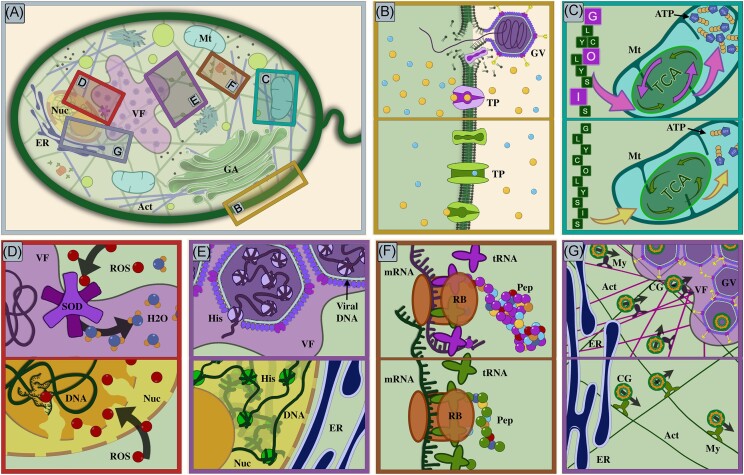Figure 2.
Illustration of possible roles of virologs in diverse processes within virocells. Panel (A): overview of a eukaryotic cell featuring key organelles and a virus factory. Each area highlighted using rectangles of different colors is shown in detail in panels (B)–(G). The top halves of panels (B)–(G) represent processes in infected cells carried out in part by virus-encoded virologs, while the bottom halves represent processes as they occur in healthy cells. Virus-encoded proteins and related processes or organelles are shown in shades of purple. Panel (B): virus infection of a cell and subsequent injection of viral DNA initiate reprogramming of the healthy cell metabolism into a virocell. Viral-encoded potassium channels cause depolarization of the host membrane and thereby facilitate viral entry. In the virocell, viral-encoded transporters help import nutrients, facilitating the infection process. Panel (C): virologs involved in central carbon metabolism (glycolysis and TCA cycle—purple letters and arrows) potentially augment cellular energy metabolism, leading to increased production of ATP. Panel (D): ROS cause damage to cellular components. During viral replication, viral-encoded SODs potentially prevent damage to viral proteins and nucleic acids within the virocell. Panel (E): While histones in a regular cell contribute to the structural organization of cellular DNA, within a virocell, viral-encoded histones can help package and organize viral DNA within the capsid. Panel (F): many GVs encode tRNAs in their genomes, which can potentially augment the cellular tRNA pool to sustain viral protein production. Panel (G): although the functions of viral-encoded actin and myosin genes have yet to be characterized, they could potentially assist in the localization and structure of the virus factory. Viral myosin might help transport molecular cargoes related to virus replication and assembly processes along the actin filaments. Abbreviations: Nuc—nucleus, ER—endoplasmic reticulum, VF—virus factory, Mt—mitochondria, GA—Golgi apparatus, Act—actin filaments, GV—giant virus, TP—transporters, ROS—reactive oxygen species, SOD—superoxide dismutase, H2O—water, His—histone, RB—ribosome, Pep—peptide chain, tRNA—transfer RNA, My—myosin, and CG—molecular cargo.

